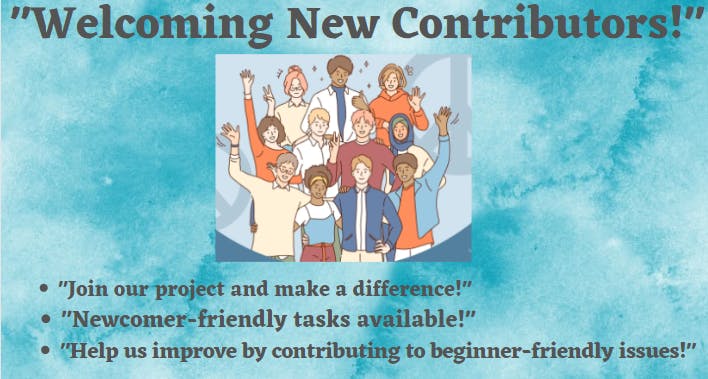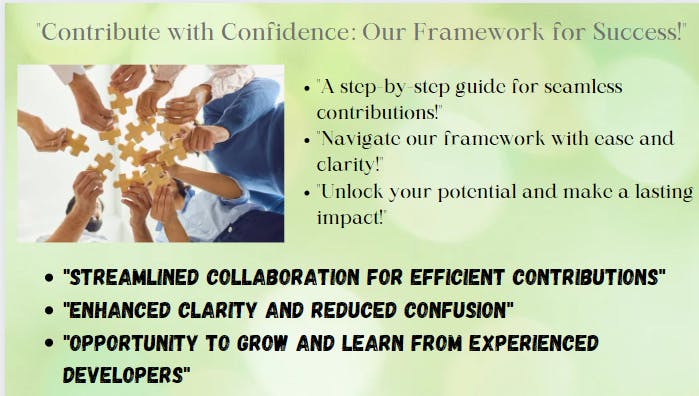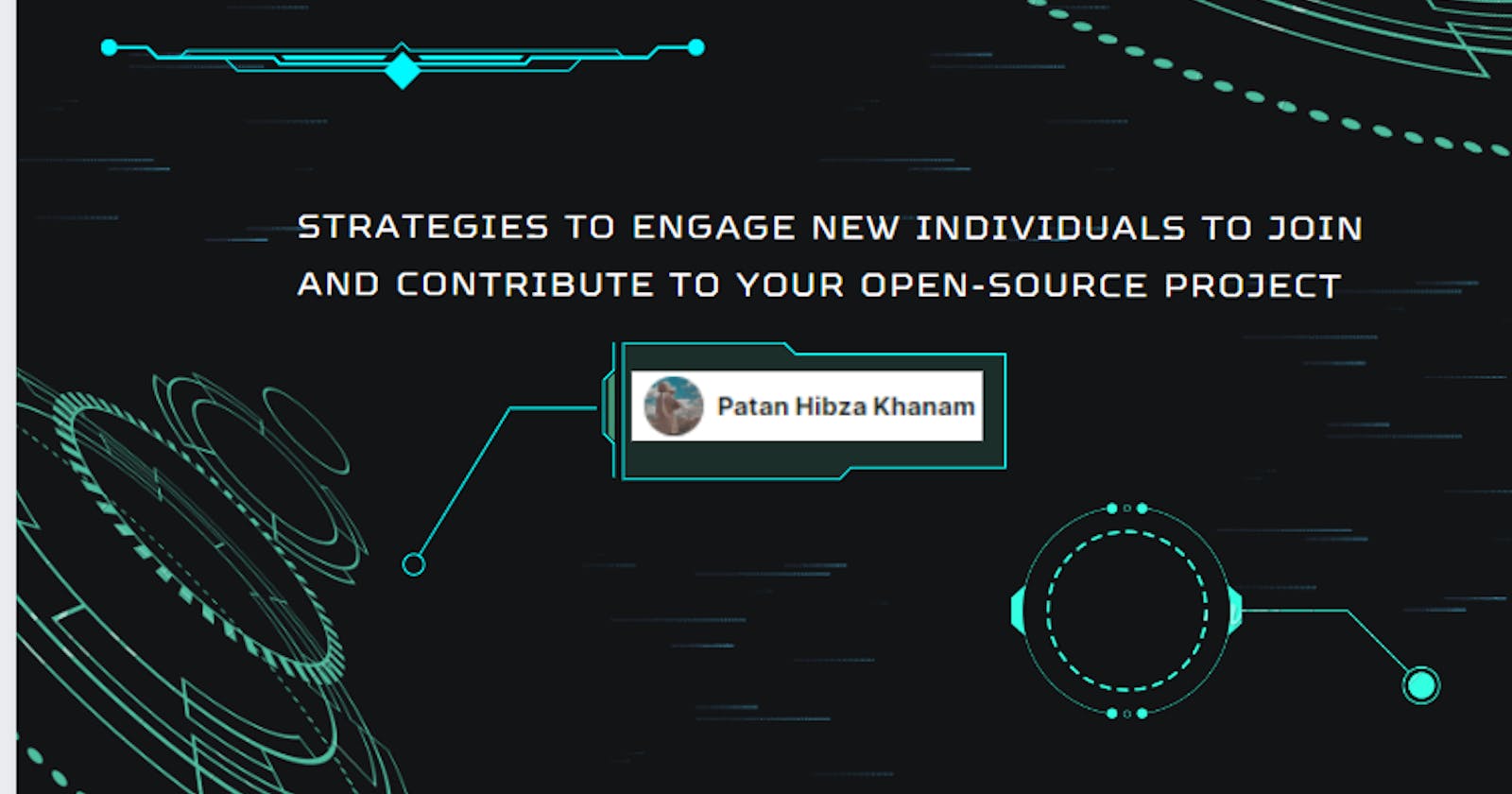Strategies to engage new individuals to join and contribute to your open-source project
Table of contents
- Introduction
- Unlocking Collaboration: Proven Tactics to Attract and Empower Fresh Contributors in Your Open-Source Community
- Strategy #1: Label beginner issues appropriately
- Strategy #2: Implement a well-defined framework for contributing instructions
- Strategy #3: Document the conceptual framework, technical structure, and organizational hierarchy of your project
- Strategy #4: Simplify the contribution process by creating standardized templates for pull requests and issues
- Strategy #5: Embrace all contributions with open arms.
- Strategy #6: Show appreciation and reward new contributors for their contributions, acknowledging their valuable contributions to the project.
- Conclusion
Introduction
Want to take your open-source project to the next level? Discover the secrets of attracting a wave of new contributors. It's time to break free from the echo chamber and involve the very individuals we aim to attract. In this blog, I will try to uncover practical insights and actionable tips for making your project more enticing to new contributors. Without wasting any time, let's dive straight into the heart of the matter.
Unlocking Collaboration: Proven Tactics to Attract and Empower Fresh Contributors in Your Open-Source Community
Attracting new contributors to your Free and Open Source Software project, especially those new to open-source, can be challenging. Many project maintainers recognize the importance of creating a beginner-friendly environment to welcome and engage these new contributors.
However, the discussion surrounding this topic often remains confined within the echo chamber of maintainers. To truly address this issue, it is crucial to involve the other key stakeholders-the new contributors themselves. By actively seeking their input and incorporating their perspectives, we can better understand their needs, concerns, and aspirations.
This inclusive approach will foster a more collaborative and supportive open-source community, ultimately attracting and retaining diverse contributors involving the other key stakeholders the new contributors are crucial.
Strategy #1: Label beginner issues appropriately
Having well-defined labels facilitates the identification of issues that can act as a starting point for newcomers to make their initial contributions. The absence of such labels significantly increases the level of difficulty for individuals seeking to contribute to your project.
To assist individuals who are unfamiliar with your codebase, relying solely on a generic label like "help wanted" is insufficient in conveying the difficulty level of an issue. Instead, consider utilizing more specific labels such as "beginner-friendly," "accessible," or "introductory" to communicate that a particular issue is suitable for an initial contribution. By using these more descriptive labels, you can effectively guide newcomers toward tasks that are appropriate for their skill level.

Strategy #2: Implement a well-defined framework for contributing instructions
A comprehensive guide for contributors can be created, outlining the expected workflow and instructions for participating in your project. This documentation, often referred to as "Contribution Guidelines", serves as a valuable resource, saving both contributors and maintainers considerable time by providing clear instructions and expectations.
It is important to specify whether contributors are required to work on separate branches for each issue or if they need to squash their commits and rebase their changes before submitting a pull request (PR). In your contribution guidelines, clearly outline the preferred approach and provide links to relevant tutorials or resources for contributors who may be unfamiliar with these processes. This will ensure that contributors understand the expectations and have access to the necessary information to follow the recommended workflow.

Strategy #3: Document the conceptual framework, technical structure, and organizational hierarchy of your project
Having a comprehensive document that provides a high-level overview of your project's design and architecture can greatly streamline the collaboration process for both contributors and maintainers. This document serves as a valuable reference, saving time for all parties involved by providing a clear understanding of the project's overall structure and design principles.
Rather than repeatedly explaining the same concepts to each new contributor, it is beneficial to observe and record frequently asked questions (FAQs) and compile them into an FAQ section within your README.md file. This practice helps streamline the onboarding process for new contributors by providing readily available answers to common queries. By having an accessible FAQ section, you can save time and effort for both contributors and maintainers.
To assist new contributors in navigating complex codebases, it is crucial to provide a clear and descriptive overview of your project's folder structure. By offering a detailed explanation of the organization and purpose of each directory, you can help newcomers understand the layout of the codebase and locate specific components or functionalities more efficiently. This helps to alleviate the initial challenges faced by new contributors and facilitates their integration into the project.
Create informative documents that highlight the architectural decisions and reasoning behind them, specifically targeting junior developers who may be less familiar with common design patterns. By offering these resources, you can empower new contributors to understand and contribute effectively to the codebase, fostering a more inclusive and collaborative development environment.

Strategy #4: Simplify the contribution process by creating standardized templates for pull requests and issues
Having a well-designed issue template enables contributors to provide comprehensive information regarding the necessary environment to reproduce a bug. By including all relevant details in one place, contributors can immediately begin working on the issue without having to collect information from various sources. This efficient approach saves time for both contributors and maintainers.
Similarly, pull request templates play a crucial role in streamlining the contribution process. They outline clear expectations for contributors when submitting a pull request, such as the required format for commit messages, the test plan, and the specific changes made. This not only facilitates code review but also further reduces the overall time spent by all parties involved.
By implementing both issue and pull request templates, you optimize efficiency, enhance collaboration, and save valuable time throughout the entire contribution and review process.
Strategy #5: Embrace all contributions with open arms.
Break free from the prevalent bias against non-code translations in our field. Instead, foster a project culture that values and encourages diverse contributions, including documentation, code, typo fixes, tests, and any other form of contribution. Create an inclusive environment where all contributions are appreciated and celebrated.

Strategy #6: Show appreciation and reward new contributors for their contributions, acknowledging their valuable contributions to the project.
If feasible, consider rewarding new contributors by sending them swag items like stickers or shirts, as a token of appreciation for their efforts. In cases where budget constraints prevent such rewards, a simple shoutout or mention in a blog post or on social media can still have a significant impact. This gesture ensures that contributors, regardless of the size of their contributions, understand that their efforts are recognized and valued. By fostering a sense of belonging and appreciation, you can inspire them to continue contributing and actively participate in the project.

Conclusion
In conclusion, engaging new individuals to join and contribute to your open-source project requires a thoughtful approach and the implementation of effective strategies. By implementing these strategies, you can attract, engage, and retain new contributors, building a thriving open-source community that benefits from a diverse range of skills and perspectives. Together, you can drive the growth and success of your open-source project.
🌟 Thank you for investing your time in reading my blog! Your engagement means the world to me, and I genuinely hope you found it insightful and valuable. 🙏
If the content resonated with you and you learned something new, I would be incredibly grateful if you could support me in a few ways:
🧡Like the Blog: Show your appreciation by giving the blog a🧡to let me know you enjoyed it.
👉 Follow Me on Hashnode: Stay updated with my latest posts and discoveries by following me on Hashnode. I'll continue sharing exciting insights and meaningful content that I believe will benefit you.
✉️ Subscribe to My Newsletter: Don't miss any of my future blogs and updates by subscribing to my newsletter. It's a great way to receive curated content directly in your inbox.
I'm passionate about sharing knowledge and insights, and your support motivates me to keep writing and exploring new topics. Thank you for being a part of this journey with me! Together, we can continue to learn, grow, and make a positive impact in the digital world.
Email Id: patanhibza786@gmail.com
